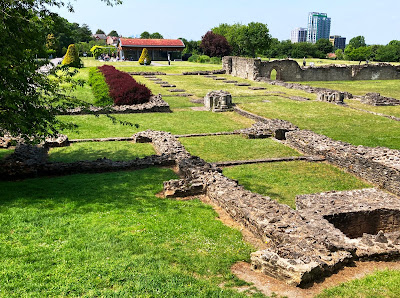Wednesday was another day that didn’t quite go according to plan.
It started whilst I was having my morning shower in the bathroom on the top floor of our house. I was just finishing when Sue called up, ‘Do you know that there is water dripping through the ceiling?’ Resisting the temptation to reply in a sarcastic fashion that of course I did (In truth, I had no idea that there was a problem), I dried myself off as best I could and went down to the first floor … and found that water was indeed dripping through a small crack in the ceiling. It was immediately obvious that there was a problem with the outflow pipe from the shower, and as soon as I was dressed, I phoned our insurers and arranged for them to send a plumber round to fix it on Friday.
As we had planned to do our weekly food shop on Friday, it was obvious that we had to change our plans and do it today. This meant that we had to move what we had planned to do on Thursday to Wednesday … and so after eating a late breakfast at a cafe in nearby Welling and dropping off some electrical goods at the local branch of Emmaus, we went to Lesnes Abbey.
Rather like The Point that Sue and I visited a few weeks ago, Lesnes Abbey is one of those little-known gems that one can find in London. It occupies a position on high ground overlooking the River Thames to the east of London in the London Borough of Bexley. The land was given to Bishop Odo* after the Norman Conquest, and the abbey was founded in 1178 by Richard de Luci, the Chief Justiciar of England. This was probably an act of penance for his role in the conflict between Henry II and Thomas Becket, the Archbishop of Canterbury, which resulted in the latter's murder in 1170 by four of knights. De Luci resigned from his position in 1179 and retired to the abbey. He died there three months later, and he was buried in the abbey’s Chapterhouse.
The abbey was one of the first to be closed when Henry VIII authorised the dissolution of the monasteries. Despite owning quite a large amount of land, it never been a rich establishment, and after its closure in 1525 almost all of its buildings were demolished by 1534. The land then passed through the hands of several owners until 1633, when it was bequeathed to Christ’s Hospital. The site was bought by the London County Council in 1930 and opened as a public park a year later, and it is now owned and run by the London Borough of Bexley.
The location of Lesnes Abbey and its layout
A map of the park in which Lesnes Abbey is located. Click on the map to enlarge it.
An artist's impression of what the exterior of the abbey would have looked like. Click on the image to enlarge it.
An artist's impression of what the interior of the abbey church would have looked like. Click on the image to enlarge it.
A floor plan of the abbey. Click on the image to enlarge it.
The ruins of the abbey
The abbey site also boasts a lookout point from which you can look out over London, ...
... a mulberry tree (which is very similar to the one at Charlton House!), ...
... and a carved statue of a monk.
Sue and I had a great time at Lesnes Abbey, and we will no doubt return there again in the future.
* Bishop Odo was William the Conqueror’s half-brother and was probably the second most powerful person in England after the Conquest.















































.jpeg)










Interesting hearing about these different areas of London I've not heard of before Bob. Keep em coming!
ReplyDeleteNundanket,
DeleteCheers! I’m very lucky that I live in southeast London, which has all sorts of interesting and little-known places one can visit.
All the best,
Bob
As Chris has said above, you are certainly show casing some real hidden gems Bob:). Let's hope ther are more you can share with us.
ReplyDeleteSteve J.,
DeleteI have several more places that I want to visit and share … so keep reading my blog regularly!
All the best,
Bob
This is a beautiful little find. If my family ever travels to London I'll just pull up the list of parks you've visited
ReplyDeleteMr. Pavone,
DeleteIf you ever make it to London, you’ll be bowled over by how nice the bits that aren’t touristy can be. I could write a list of things that I’d suggest tourists avoid (e.g. going to Leicester Square and Oxford Street, taking one of the cycle rickshaws) and make use of (e.g. public transport … but only if you use the ‘touch and go’ payment system, which works with things like ApplePay and contactless credit cards).
All the best,
Bob